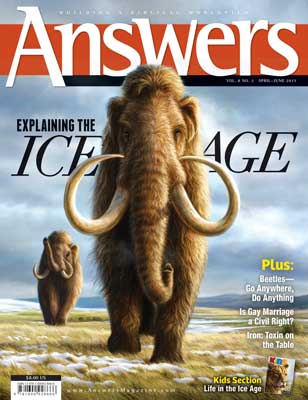
Nanobots Show Promise with Artificial Muscle
How scientists are using God's inherent design in flagella to reimagine nanotechology possibilities and applications
Doctors dream of the day when they can send micro-machines up our bloodstream to attack cancers and deliver medicines. Scientists can make ever-tinier motors, but they still lack muscle. The design of elephant trunks and octopus legs may hold the secret.
Inside your body, bacteria whip their spiral-like “tails,” or flagella, to zip from place to place. Doctors would love to harness this nanotechnology to send remote-controlled nanobots into human bodies and target diseases such as cancer. But researchers have discovered that they can’t simply miniaturize standard engines.1 In addition to small motors, they have to put some muscle into it—artificial muscle, that is.
According to Revelation 4:11, a choir around God’s throne declares that all honor belongs to Him for His amazing creation. The evidence of His handiwork extends all the way down to bacteria. While doctors still cannot fully copy the locomotor ability of bacteria, researchers have already pumped out some promising designs.
To make a nanobot move, you face two challenges. You need a form of locomotion and a way to energize it. Researchers recently flexed some brainpower to discover a way to do both by taking the bacteria’s flagellum and adding a twist.
Inside the nanobots, the scientists stretched out some “yarn” made of carbon nanotubes, and filled the bot with liquid electrolytes (also found in batteries and sports drinks). Adding an electrical charge causes the yarn to rotate in one direction at up to 600 revolutions per minute. When the charge is reversed, it then rotates the other direction.2 This method of movement is similar to how elephants move their trunks and octopuses work their legs. Long muscle fibers squeeze against a dense core that resists compression. With this design, these animals can move their long, flexible appendages without a solid skeleton.
While this discovery has certainly flexed some creative muscle, models built using this and similar methods aren’t good enough to power full-fledged robots just yet.3 But the future is promising. You could say that these artificial muscles are just getting warmed up. And in the end, the honor will still go to the Creator, who designed both the bacteria and the human brains that can imitate His designs . . . once we work out the kinks.
Answers Magazine
April – June 2013
What unique conditions were required to start the Ice Age, and where does it fit in Bible times? Why did Ice Age animals grow so big, and what happened to them? Also, can you explain why God made more species of beetles than any other animal? Can you prove that Genesis 1–3 is not a Near Eastern myth? Read the answers to these questions and many, many more in this issue!
Browse Issue SubscribeFootnotes
- How small is “nano”? A millimeter is one-thousandth of a meter, a micrometer is one-thousandth of a millimeter. A nanometer is one-thousandth of a . . . well, you get the point. We’re talking about tiny, atomic level, here.
- Javad Foroughi, Geoffrey M. Spinks, Gordon G. Wallace, Jiyoung Oh, Mikhail E. Kozlov, Shaoli Fang, Tissaphern Mirfakhrai, John D. W. Madden, Min Kyoon Shin, Seon Jeong Kim, and Ray H. Baughman, “Torsional Carbon Nanotube Artificial Muscles,” Science 334, no. 6055 (October 2011): 494–497; Márcio D. Lima, Na Li, Mônica Jung de Andrade, Shaoli Fang, Jiyoung Oh, Geoffrey M. Spinks, Mikhail E. Kozlov, Carter S. Haines, et al., “Electrically, Chemically, and Photonically Powered Torsional and Tensile Actuation of Hybrid Carbon Nanotube Yarn Muscles,” Science 338, no. 6109 (November 2012): 928–932; see also http://www.sciencemag.org/content/suppl/2011/10/12/science.1211220.DC1/Foroughi.SOM.pdf.
- “New Soft Motor Made from Artificial Muscles,” Science Daily, http://www.sciencedaily.com/releases/2012/02/120215155313.htm; and Benjamin M. O’Brien, Thomas G. McKay, Todd A. Gisby, and Iain A. Anderson, “Rotating Turkeys and Self-Commutating Artificial Muscle Motors,” Applied Physics Letters 100 (2012), https://aip.scitation.org/doi/10.1063/1.3685708.
Recommended Resources

Answers in Genesis is an apologetics ministry, dedicated to helping Christians defend their faith and proclaim the good news of Jesus Christ.
- Customer Service 800.778.3390
- © 2024 Answers in Genesis





